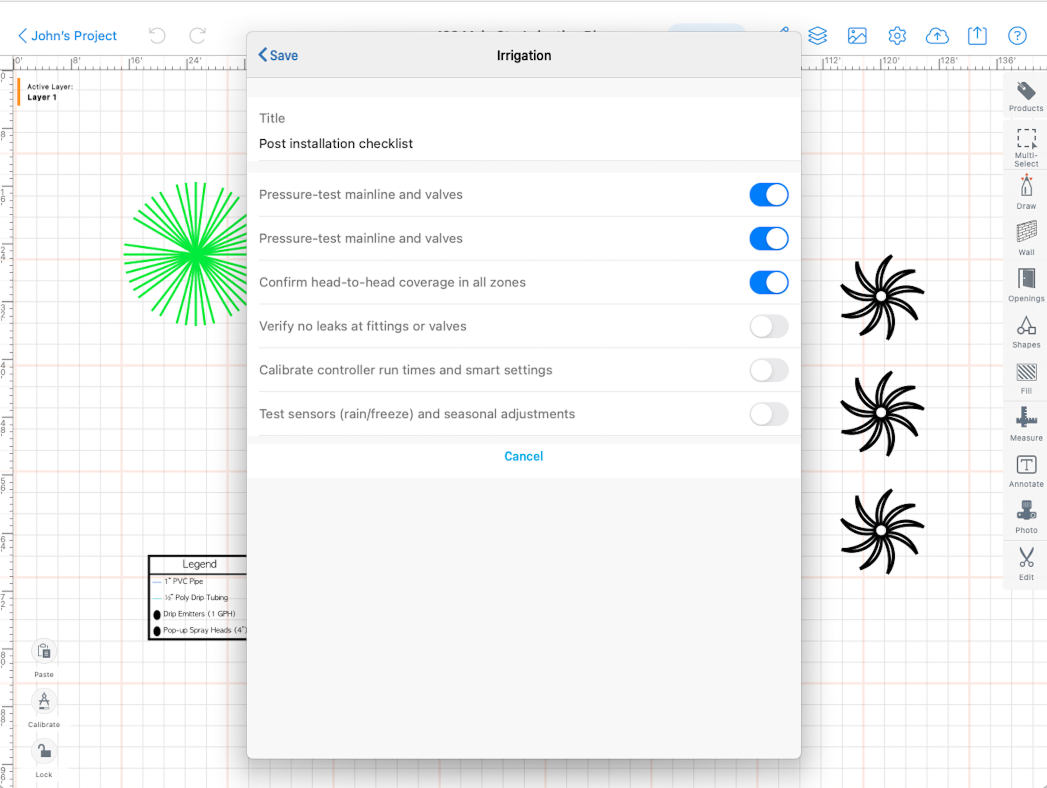Irrigation Checklists Can Save Your Crew from Costly Callbacks



1. Introduction
You show up to a job, the system looks okay at a glance, you hand off the remote and move on to the next site. Then three weeks later a line bursts, a head’s misaligned, a head’s spraying the sidewalk and you’re back — digging, fixing, explaining. That’s re‑work. It eats time. It eats profit. It messes with your reputation.
Here’s the truth: for irrigation contractors and crews, the difference between a one‑and‑done job and a callback nightmare often comes down to inspection. A solid irrigation inspection checklist catches the issues before they trigger repair orders. In this post we’ll walk through: where irrigation jobs go off course, what to include in a high‑impact checklist, why digital checklists outperform scribbled paper forms, and how using the right mobile tool makes everything smoother. Let’s get you set up so your work gets done right the first time.
2. Where Irrigation Re‑work Happens Most
Even experienced crews hit trouble spots. Here are the common & costly issues:
[fs-toc-omit]2.1 Missed Valve Locations or Back‑flow Devices
Valves buried under shrub roots, back‑flow preventers installed backward or without proper clearance… these create headaches. Once the client notices a puddle or the yard gets soggy, you’re back onsite.
[fs-toc-omit]2.2 Sprinkler Head Misalignment & Overspray
Heads aimed at sidewalks, buildings, hardscapes, or too low or too high relative to grade. Overspray onto pavement = wasted water, pissed‑off neighbors, erosion risk, and callbacks.
[fs-toc-omit]2.3 Zone Testing Skipped or Incomplete
You might think you ran each zone, but did you test under full pressure? Did you inspect for leaks, clogs, and head uniformity? Did you capture conditions after irrigation started? If not, you’re leaving guess‑work on the table.
[fs-toc-omit]2.4 Leaks or Pressure Issues After Burial
A hidden cracked pipe or joint that was never checked under flow ends up surfacing when roots grow, the homeowner notices wet spots, or worse: the city issues a violation.
These are the places your checklist must hit. Catch them early, fix them early, or you’ll be paying for them later.
3. What to Include in Your Irrigation Inspection Checklist
Here’s a field‑tested, contractor‑friendly inspection list you can use or adapt:
[fs-toc-omit]Before Installation / Pre‑Start
- Site walk done with homeowner/client: mark high‑traffic zones, slopes, obstacles
- Review of landscape plan and irrigation layout
- Utilities clearly marked and located
- Water source and static/dynamic pressure measured
- Controller location confirmed, timer compatibility checked
[fs-toc-omit]During Installation
- Valve locations staked and accessible, labeled properly
- Main & lateral pipe runs pressure‑tested and flushed before burial
- Heads and drip lines installed at correct spacing, height, and orientation
- Backflow preventer installed per code, labeled and covered
- Pipes insulated or protected if required
[fs-toc-omit]After Installation / Final Inspection
- All zones run fully: check for leaks, proper coverage, uniform spray, no runoff onto hardscape
- Drip systems: emitters flush, filters clean, uniform delivery
- Static & dynamic pressure recorded, zones performing at design spec
- Controller programmed and tested: start times, run times, days, cycle/soak if needed
- Client walkthrough: timer demo, schedule explanation, any warranty/maintenance info given
- As‑built drawing saved, photos captured of each zone/job area
- Check for overspray, pooling, low head drainage, mismatched nozzles
- Documentation stored (digital preferred) so you have proof of job condition at hand‑off
4. Why Digital Checklists Outperform Paper
Here’s why ditching the clipboard makes day‑to‑day easier:
- You can’t lose your phone. You can lose a clipboard with paper forms.
- Timestamps and GPS tagging enforce accountability for crews.
- You can snap photos and attach them to each checklist item – great for proof if things go sideways.
- You store everything digitally and tie it to the job file; when a problem arises later, you have the original inspection as backup.
- Using mobile tools, you can auto‑send the report or checklist to your office, client, or as part of the proposal package.
- And when your drawing, checklist, and job file are linked (via software) you reduce the chance of mis‑communication or parts being skipped.
In short: digital checklists help you work smarter, protect yourself, and deliver confidence to clients.
5. How ArcSite Helps You Build and Use Smart Checklists

If you’ve used a paper form and thought “Wish I could just tap and go”, here’s how you can with a tool like ArcSite.
- Create a reusable checklist template tailored to irrigation inspection workflows.
- Integrate your site drawing overlay heads, valves, lines and then link each to an inspection item.
- On‑site you tap the item: mark it complete so you can move on. Add fields to upload notes or photos.
- You attach inspection results to your proposal or job file: when you turn the job over or come back for maintenance, you’ve got history.
- When the job is done, you archive the inspection report, drawings, photos, checklist in the job folder — everything tied to the estimate and invoice. With all that, you’re not just doing inspections—you’re building client trust, reducing callbacks, and protecting your margin.
6. Final Takeaways
- Re‑work is expensive. The jobs that look quick can end up costing you or your client time, money, and reputation.
- An irrigation inspection checklist isn’t just “nice to have”—it’s a job‑saving tool.
- Cover the stages: pre‑start, installation, final walkthrough. Catch the tiny leaks, misalignments, skipped tests before they become hillside issues.
- Go digital. A mobile inspection checklist connected to drawings and job files keeps you efficient, documented, and accountable. ArcSite runs on phones and tablets so you'll always have your checklist handy tied to each project.
- Use tools like ArcSite to tie your inspection to your drawing, estimate and invoice lifecycle. That means less guesswork, fewer callbacks, and a stronger business.
7. What's Next?
Want to make inspections your strength instead of your stress? Try ArcSite today. Build your field‑ready inspection templates, attach drawings, capture photos, generate reports & tie everything to your job file in one app. Make ‘done right’ your standard.
[fs-toc-omit]Get a free demo and trial for your team
As a bonus, check out:
- Free Landscaping Tools - Drawings, business templates, and CAD blocks
- Irrigation Software Overview
Categories
Related posts
Not quite ready for a demo? Start a free 14-day trial of ArcSite with no credit card required!
Available on iOS, Android, and Windows devices.







.png)











